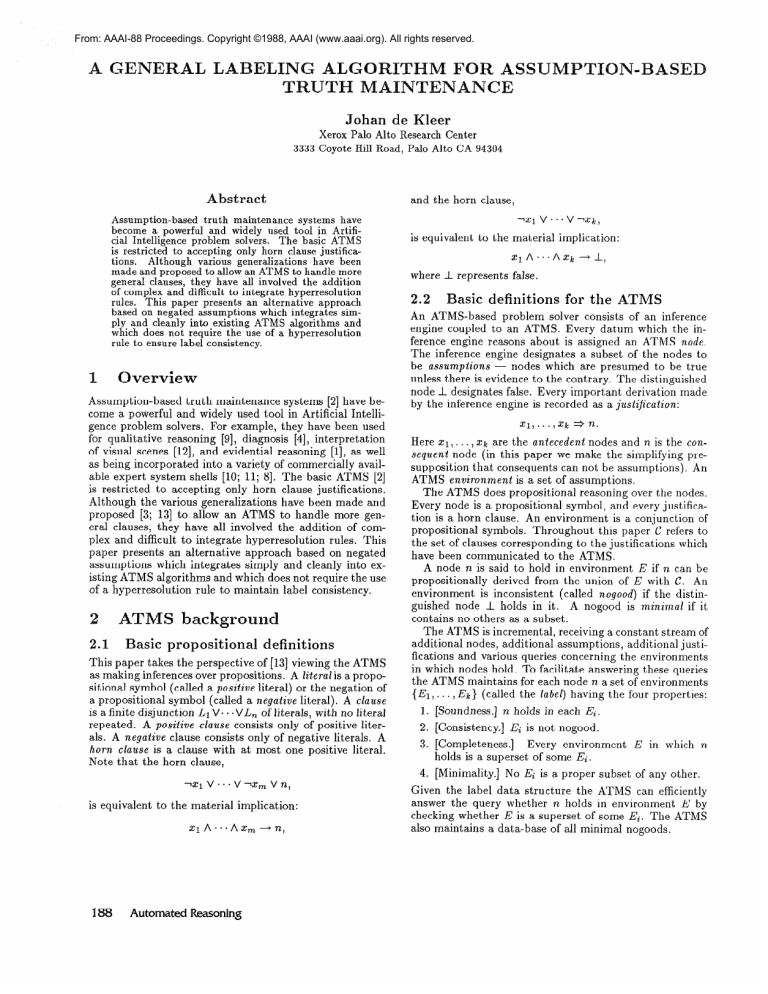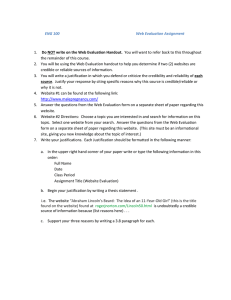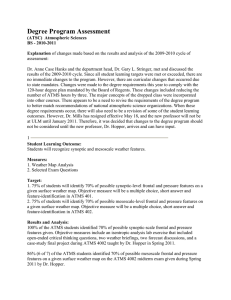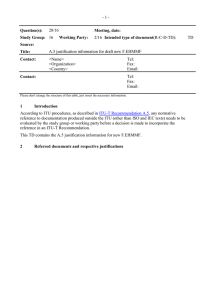
From: AAAI-88 Proceedings. Copyright ©1988, AAAI (www.aaai.org). All rights reserved.
A GENERAL
M FOR ASSUM
ENANCE
LA
Johan de Kleer
Xerox Palo Alto Research Center
3333 Coyote Hill Road, Palo Alto CA 94304
Abstract
and the horn clause,
Assumption-based
truth maintenance svstems have
become a powerful and widely used to”ol in Artificial Intelliaence Droblem solvers. The basic ATMS
is restrictevd to accepting only horn clause justifications.
Although various generalizations have been
made and proposed to allow an ATMS to handle more
general clauses, they have all involved the addition
of complex and difficult to integrate hyperresolution
rules. This paper presents an alternative approach
based on negated assumptions which integrates simply and cleanly into existing ATMS algorithms and
which does not require the use of a hyperresolution
rule to ensure label consistency.
I
Overview
Assumption-based
truth maintenance
systems [2] have become a powerful and widely used tool in Artificial Intelligence problem solvers.
For example,
they have been used
for qualitative
reasoning
[9], dia&dsis
[4], interpretation
of visual scenes [12], and evidential
reasoning - -[ll, as well
as being incorporated
into a variety of commercially
available expert system shells [lo; 11; 81. The basic ATMS [2]
is restricted
to accepting
only horn clause justifications.
Although
the various generalizations
have been made and
proposed
[3; 131 t o allow an ATMS to handle more general clauses,
they have all involved the addition
of complex and difficult to integrate
hyperresolution
rules. This
paper presents
an alternative
approach
based on negated
assumptions
which integrates
simply and cleanly into existing ATMS algorithms
and which does not require the use
of a hyperresolution
rule to maintain
label consistency.
2
2.1
A’I’MS backgrcnmd
Basic propositional
definitions
This paper takes the perspective
of [13] viewing the ATMS
as making inferences over propositions.
A literalis
a propositional symbol (called a positive literal) or the negation of
a propositional
symbol (called a negative literal).
A cdause
is a finite disjunction
L.1 V. . -VL, of literals, with no literal
repeated.
A positive clause consists only of positive literals. A negative clause consists only of negative literals.
A
horn clause is a clause with at most one positive
literal.
Note that the horn clause,
is equivalent
188
to the material
implication:
Automated Reasoning
is equivalent
to the material
implication:
x1 A * *. A xk ---f ste,
where
I
represents
false.
2.2
Basic definitions
for the ATOMS
An ATMS-based
problem
solver consists
of an inference
engine coupled to an ATMS.
Every datum which the inference engine reasons about is assigned an ATMS
node.
The inference
engine designates
a subset of the nodes to
be assumptions
nodes which are presumed
to be true
unless there is evidence to the contrary.
The distinguished
node I designates
false. Every important
derivation
made
by the inference engine is recorded as a justification:
Xl,..-, Xk 3
n.
Here x1, . . . , xk are the antecedent nodes and n is the consequent node (in this paper we make the simplifying
presupposition
that consequents
can not be assumptions).
An
is a set of assumptions.
ATMS environment
The ATMS does propositional
reasoning over the nodes.
Every node is a propositional
symbol, and every justification is a horn clause.
An environment
is a conjunction
of
propositional
symbols.
Throughout
this paper C refers to
the set of clauses corresponding
to the justifications
which
have been communicated
to the ATMS.
A node n is said to hold in environment
E if n can be
propositionally
derived from the union of E with C. An
environment
is inconsistent
(called nogood) if the distinguished node I holds in it.
A nogood is minimal if it
contains no others as a subset.
The ATMS is incremental,
receiving a constant stream of
additional
nodes, additional
assumptions,
additional justifications
and various queries concerning
the environments
in which nodes hold. To facilitate
answering
these queries
the ATMS maintains
for each node n a set of environments
, Ek} (called the label) h aving the four properties:
{El,...
1. [Soundness.]
n holds
in each
Ei.
Ei is not nogood.
2.
[Consistency.]
3.
[Completeness.]
Every environment
holds is a superset
of some Ei.
E
4.
[Minimality.]
of any other.
No Ei is a proper
subset
in which
n
Given the label data structure
the ATMS
can efficiently
answer the query whether
n holds in environment
E by
checking whether E is a superset
of some Ei. The ATMS
also maintains
a data-base
of all minimal nogoods.
The central task of the ATMS is to maintain
node labels.
The only operation
which can change any node’s label is
the addition of a justification.
When a new justification
J
is supplied to the ATMS PROPAGATE(J,
4, (0)) is intakes a particular
justification,
an
voked. PROPAGATE
optional antecedent
node a (absence is indicated by $), and
I a set of environments
just added to the label of a. The
intuition
behind the algorithm
is that it assumes that node
labels are correct before the introduction
of the new justification
and therefore
it only propagates
the incremental
changes caused by a new justification.
Note that assumptions are created with labels containing
the single environment containing
itself and all other nodes are created with
empty labels. The main work of the basic algorithm
occurs
inference
in step 4 of WEAVE.
(V iewed as propositional
resolves a horn clause (i.e., a
each iteration
of WEAVE
justification)
in which h occurs negatively
with another
h.)
horn clause (i.e., h with its label) to eliminate
PROPAGATE((x1,.
ALGORITHM
1. [Compute
the
WEAVE@,
2. [Update
incremental
UPDATE(L,
and recur.]
UPDATE(L,
ALGORITHM
label
update.]
If L is empty,
I, {x1,. . . , xk}).
label
, . ,xk 3 n),u, I)
(4
n’s label
Delete
perset
04 Delete
which
(c)
n).
ensuring
call NOGOOD
1. [Termination
remaining
of n
of L to the la-
environment
I, X)
condition.]
If X
is empty,
return
choose(A1,.
. . , Ak}
nogood cri where Ai E cri and Aj+i
nogood
Ui[cui -
3. [Avoid
If h =
label.]
choose(A,
nogood(A,
nogood(B,
[Ensure that I’ is minimal and contains no known inconsistency.]
Remove from I’ all duplicates,
nogoods,
as well as any environment
subsumed
by any other.
WEAVE(u,
6. Return
ALGORITHM
1. Mark
I’, R).
NOGOOD
E as nogood.
2. Remove
E and any superset
from every
node label.
B)
C}
C}
nogood
which in propositional
4. [Incrementally
construct
the incremental
label.] Let I’
be the set of all environments
formed by computing
the union of an environment
of I and an environment
of h’s label.
5.
{Ai}]
a, return
WEAVE@,
@ oi, for all 1 5 i, j 5 L
of this rule is:
I.
Let h be the first
full
The basic algorithm
will not discover
{C} is nogood as
it can not consider
the choose.
To discover all logically
entailed
nogoods,
the full ATMS incorporates
a complex
Given a set of sets of inconsistent
hyperresolution
rule:
assumptions
ai (i.e., ATMS nogoods),
and a positive clause
(i.e., an ATMS choose):
An instance
2. [Iterate over the antecedent
nodes.]
node of the list X, and R the rest.
computing
the
I, R).
It is not possible
to encode every possible
propositional
formula as a set of horn clauses. As many problem solvers
wish to express arbitrary
propositional
formulas
relating
the basic ATMS
to
nodes and assumptions,
[3] extends
accept positive clauses of assumptions.
Given the assumpchoose(A1,
. . . . A,},
represents
the positions Al, . . . . A,,
It is possible
to express every
tive clause Al V . . . V A,.
propositional
formula as a set of horn clauses and positive clauses of assumptions.
The full ATMS accepts both
justifications
and chooses as input.
The specification
of the full ATMS follows section 2.2 except that the initial clause set C contains a positive clause
corresponding
to each choose. Unfortunately,
given the expanded clause set, the label algorithm
outlined in the previous section no longer ensures label consistency
or completeness.
By far the most serious problem is the loss of
label consistency
namely there are nogoods
logically
entailed by the clauses in C which the algorithm
does not
find. Consider
the following set of chooses and justifications (upper-case
letters
in ATMS input always refer to
assumptions):
choose{A,
B},
B,C*I.
is a su-
L which
of n.
from the label
every environment
is a superset
of some element of L.
WEAVE(a,
yperresolution
A,C+I,
3. [Propagate
the
incremental
change
to n’s label
J
For every justification
to its consequences.]
in which
n is mentioned
as an antecedent
call
PROPAGATE(
J, n, L).
ALGORITHM
4
minimality]
every environment
from
of some label environment
Add every
bel of n.
=
n)
1. [Detect nogoods.]
If n = I, then
on each E E L and return {} .
2. [Update
L
return.
This label propagation
algorithm
is easily shown to terminate and through careful choice of data structures
can be
made very efficient.
form is:
AvB
~Av-C
~Bv-6’
-c
5
Negate
assumptions
how any clause can be
An earlier paper [3] d emonstrates
encoded as a set of ATMS inputs.
However, those encodings require the introduction
of extraneous
assumptions,
needless additional
justifications,
and the many computational and implementational
complications
introduced
by
de Kleer
189
the use of the hyperresolution
rule.
We present
an extended ATMS
(NATMS
Negated
assumption
ATMS)
which achieves
label consistency
without
the use of the
hyperresolution
rule, integrates
well with the basic algorithm,
produces
more complete
node labels,
and, when
needed,
allows arbitrary
clauses to be encoded more efficiently and parsimoniously.
The NATMS allows negated
assumptions
to appear directly in justification
antecedents.
The negation
of assumption
A is a non-assumption
node
and is referred to as 1A.
Every choose is easily encoded as an NATMS justiflcation. For example,
the choose,
choose{A,
is expressed
by the NATMS
B, C)
For example,
given
the new nogood:
emptylabels,
initially
nogood(A,
B, C},
the NATMS produces the following
L is the label for node representing
(4
which has the same
justifications:
HB,
(where
2):
w>
(x:, L) indicates
Y
(-7
WY
CH),
t-c>
w,
W)~
effect
on discovering
as having
installed
the following
A,B=wC,
justification,
A,C
*
‘B,
B,C=FA.
Therefore,
any full ATMS problem can be trivially
translated into an NATMS
problem.
The specification
of the NATMS
follows section 2.2 extended to allow antecedents
to justifications
to include
negations
of assumptions
but negated
assumptions
may
not appear in justification
consequents’.
The input clause
set C is produced by treating justifications
as material
implications
and translating
them to clausal form.
For exa,lB
+ c corresponds
to the
ample, the justification:
clause -XV B V c (lower-case
letters in ATMS input always
refers to non-assumption
nodes).
This example illustrates
the NATMS is more general than the full ATMS
which
can only directly represent
positive clauses of assumptions
(i.e., chooses).
6
The
extended
expressed
in the propositional
calculus
AAB--+S’,
A/\C-+TB,
BAC--+--,A.
The basic ATMS
algorithm
is based on the idea that add
label updates
can be determined
by propagating
environments
forward through justifications.
Remaining
with
propagation
has the basic technique,
it is easy to see that
it is necessary
to encode all of these material
implications
as justifications.
Fortunately,
it is also sufficient to ensure
label consistency.
Therefore
the NATMS algorithm
incorporates
the equivalent to the following inference rule for minimal nogoods:
nogood{A,
Al, . . . , Ak}
Ak =S 1A
‘The current implementations
of all three forms of the
ATMS place no restrictions on the consequents of justifications.
However, greater care must be taken in the specifications and
algorithms than space allows here.
190
Automated Reasoning
example
of section
‘A,
1B
+
4 is encoded
as follows:
I,
Communicating
these to the ATMS immediately
produces
the two nogoods {A, C} and {B, C} to which the minimal
nogood rule applies 4 times producing:
which
when propagated
to the justification,
‘A,
TAVTBV-C,
Al,...,
resolution
algorithm
The extended
labeling
algorithm
is based on the observation that any negative
clause of size k is logically
equivalent to any of the k implications
with one literal on its
right-hand
side. For example,
can be equivalently
as any of:
The
1B
+
I,
results in the discovery of the new nogood {C} as desired.
Note that it is unnecessary
to compute the label for 1A
unless that node appears as an antecedent
to some justification.
Therefore,
if there are no justifications
referring
to a negation
of an assumption,
the NATMS
is identical
to the basic ATMS.
Only one step has to be added to the
function
NQGOOD
to achieve label consistency.
ALGORITHM
NOGOOD’
3. [Handle negated
assumptions.]
For every A
for which
TA appears
in some justification
UPDATE({E
- {A}},
TA).
E E
call
If assumption
A has appeared in nogoods before TA is used
in some antecedent,
then the node 1A must be created
with the initial label NOGOOD’
would have created for
it had 1A appeared in some justification
before any nogood
was discovered.
If all the NATMS
justifications
represent
either basic
ATMS justifications
(i.e., horn clauses)
or chooses (i.e.,
positive
clauses of assumptions),
then the computational
complexity
of this algorithm
is no different than the one
employing
the explicit
hyperresolution
rule. They are essentially
doing the same work; this algorithm
replaces
a
single hyperresolution
step involving a choose of size k and
k nogoods with k extended
label updates and one conventional label propagation.
Consider
the consequent
of rule
hyperresolution:
nogood (Ji [ai - (Ai )I.
Removing
each Ai from each nogood LYEis equivalent
to
constructing
the label for TAG, the iterated
union Ui over
each nogood is equivalent
to constructing
the label for the
TAG,. . . , TAk 3
I, and
consequent
of the justification
the outer nogood assertion
is equivalent
to marking
the
computed
label for I nogood.
It is important
to note that the use of negated assumptions, as the use of chooses, needs to be used with some care
as it is easy it introduce
an exponential
blowup in ATMS
computations.
The addition of any justification
can result
in the discovery of any number of nogoods, and every discovery of a new nogood of size k can cause k new label
propagations
each of which can result in the discovery
of
any number of nogoods.
This blowup in ATMS computation is purely a consequence
of the fact that a problem
may have an exponential
number of nogoods that need to
be discovered.
For many problems the expense of ensuring
label consistency
is too high and a more pragmatic
approach is to only apply step 3 of NQGQOD’
to nogoods
below a certain size. This is discussed in [5].
7
Label
The two justifications
at the beginning
of this section can
be used to illustrate
how the algorithm
ensures interpretation completeness.
According
to label consistency
node
b should have an empty environment
in its label.
Nevertheless interpretation
completeness
is ensured.
Consider
any interpretation
I. If A E I then b holds trivially.
If
A is not in I, it can only be because
it is inconsistent
to
add it. This means there is a minimal nogood say CYconsisting of A and other assumptions
of I. But the minimal
nogood inference
rule would have assigned the consistent
environment
CY- {A} t o node 1A which propagated
to b.
As Q- {A} is a subset of I, b holds in I. Thus b necessarily
holds in every interpretation.
ncoding
tricks
The NATMS negated technique allows it to encode negated
non-assumption
nodes in antecedents
as well.
For every
node n which appears negatively
in the antecedent
of some
A and add the foljustification
define a new assumption
lowing two justifications:
completeness
A 3
Although
the extended
labeling
algorithm
ensures
label
soundness,consistency
and minimality,
it does not ensure
label completeness.
Consider the following example:
If there are no other justifications,
the NATMS
will compute the label (b, {{A}})
which is incomplete
as b holds
universally.
For most problem-solving
tasks label consistency
is far
more important
than label completeness
[3] because
it is
extremely
important
to avoid useless work on inconsistent
environments.
As ensuring
label completeness
is so computationally
expensive,
the ATMS computes
the complete
label for a node only upon request.
Foregoing
label completeness
renders the NATMS
potentially
uninteresting
because the trivial algorithm
which
leaves all node labels empty obeys the three remaining
properties
of soundness,
consistency
and minimality.
Fortunately,
it is possible
to clarify how close the algorithm
approximates
full label consistency.
Note that node labels will be correct with respect to the
union of the subset of C which is horn and the implicit
justifications
installed
by the minimal nogood rule. This
ensures the following useful approximation
to completeness
(following section 2.2):
3. [Weak completeness.]
Every environment
E in which
n holds is a subset or superset
of some Ei. Every Ei
is a superset
of some E in which n holds.
Most ATMS-based
problem-solvers
construct
global solutions,
or interpretations.
An interpretation
is consistent environment
to which no other assumption
can be
added without
the combination
becoming
nogood.
It is
absolutely
crucial that the problem
solver can determine
whether a node holds or not in an interpretation.
Fortunately, the following holds.
3. [Interpretation
completeness.]
in which n holds is a superset
Every interpretation
of some .!Zi.
I
For example,
using
n,
given,
this encoding
provides:
Note that this encoding
has the inconvenience
that the
assumptions
created purely for encoding purposes now appear in node’s labels.
These assumptions
have no significance for the inference engine and should be ignored by it
(see [3]). Note also if the negated nodes appear in consequents of inference-engine
supplied justifications,
then an
additional
assumption
and justification
set must be added
to ensure total symmetry
between n and Tn.
In some cases a problem
solver may want to force the
negation of an assumption
to be an assumption
as well in
order to have it appear in node labels.
Such assumptions
must be explicitly
encoded as two justifications.
The assumption
which is the negation
of A, i.e., - A is created,
with the following two justifications
connecting
it to A:
A,-
A a
I,
-A ,1-A*-L.
This has the result that there are two expressions
for the
negation of A: (1) -,A which is not an assumption,
and (2)
- A which is an assumption.
The basic difference
is that
the assumption
N A appears in labels while node 1A does
not.
9
a&racking
The label propagation
technique
presented
in this paper is
equivalent
to installing
a set of new ATMS-created
justifications
whenever a new nogood is discovered.
This idea
is similar to the dependency-directed
backtracking
(DDB)
scheme described
by Doyle [6]. The NATMS
extended
de KIeer
191
labeling
algorithm
is, in effect,
performing
dependencydirected backtracking
in all contexts
simultaneously.
For Doyle an assumption
is a node supported
by a nonmonotonic
justification.
A non-monotonic
justification
includes an additional
outlist
of nodes which must all be
absent from a context for the consequent
to hold. The denials of the assumption
are the members of the outlist.
In
many cases assumptions
have only one denial - their own
negation.
A (justification-based)
TMS idiom is to assume
x by installing
the justification:
out -x
*
x.
This states that x holds in a context until there is support
for lx.
In NATMS terms this non-monotonic
justification
is encoded by making x an assumption,
lx the negation
of that assumption,
and discarding
the justification.
Extremely simplified,
Doyle’s DDB algorithm,
which operates
within a single context,
is as follows.
1. Find the maximal2
assumptions
tracing through the dependencies
lieved contradiction.
S = {A,, . . . , A,}
of the currently
11
12
References
PI
PI
PI
PI
{Al,...,Ai-l,Ai+l,...,A,}.
The effect of installing
the justification
in step 2 is to retract one of the current
assumptions
therefore
removing
Doyle calls this dependency-directed
the contradiction.
backtracking
because
his TMS analyzes
the dependency
structure
underlying
a contradiction
to determine
what assumption
to retract.
The NATMS
approach
is similar to
Doyle’s.
Step 1 of DDB is handled automatically
by the
ATMS as it explicitly
represents
the assumptions
underlyto applying
ing every node. Step 2 of DDB is equivalent
the extended
label rule of section 6 once.
10
Non-monotonicity
The preceding
section
suggests
there is a close connection between non-monotonic
justifications
and negated assumptions.
The ATMS
can only represent
certain kinds
of non-monotonic
justifications.
To encode general nonmonotonic justifications
in the NATMS requires more substantial extensions.
There have been a variety of proposals
to encode non-monotonic
justifications
in the ATMS,
but
most are either faulty [3] or not very general [ll]. Dressler
[7] has independently
extended
the ATMS in a very similar way to that presented
in this paper by introducing
‘Out-assumptions.’
An out-assumption
corresponds
to an
NATMS
assumption
created to represent
the negation
of
some node. He further shows general non-monotonic
justifications
can be encoded using them. However, analogous
to [ll], this requires defining a node to hold in an environment E if there is a label environment
Ei (a) which is consistent with E, and (b) f or which the non-out-assumptions
of Ei are a subset of the non-out-assumptions
of E.
2Doyle’s TMS allows assumptions to be supported by justifications and hence, ultimately, on other assumptions. An assumption is non-maximal if it only supports the contradiction
through other assumptions.
192
Automated Reasoning
Acknowledgments
Dan G. Bobrow,
David
Chapman,
Ken Forbus,
John
Lamping,
Alan Mackworth,
Vijay Saraswat,
Jeff Shrager,
and Ramin Zabih provided useful comments
on early versions of this paper.
by
be-
2. Select some Ai, the culprit from S. Force assumption
Ai out by justifying
some denial (intuitively
‘Ai)
of
the culprit with a justification
whose antecedents
are
Proofs
This paper has made many claims, without proof, that the
algorithm
achieves its specifications.
This is the subject
of a forthcoming
paper which shows that the basic, full
and negated ATMS algorithms
ensure the specified
label
properties.
PI
PI
PI
D’Ambrosio,
B., A hybrid approach to uncertainty, Interof Approximate
Reasoning,
to appear.
de Kleer, J., An assumption-based truth maintenance system, Artificial
InteZZigence
28 (1986) 127-162. Also in
Readings
in NonMonotonic
Reasoning,
edited by Matthew
L. Ginsberg, (Morgan Kaufman, 1987), 280-297.
de Kleer, J., Extending the ATMS, Artificial Intelligence
28 (1986) 163-196.
de Kleer, J. and Williams,
B.C., Diagnosing multiple
faults, Artificial
Intelligence 32 (1987) 97-130. Also in
Readings
in NonMonotonic
Reasoning,
edited by Matthew
L. Ginsberg, (Morgan Kaufman, 1987), 372-388.
de Kleer, Johan, Constraint satisfaction vs. assumptionbased truth maintenance, submitted for publication.
Doyle, J., A truth maintenance system, Artificial InteZZigence 12 (1979) 231-272.
Dressler, Oskar, Extending the basic ATMS, Proceedings
national
European
Journal
Conference
on Artificial
Intelligence,
1988.
PI
Filman, R.E., Reasoning with worlds and truth maintenance in a knowledge based system shell, Communications
of the ACM 21 (1988) 382-401.
PI Forbus, K.D., The qualitative process engine, University
of Illinois Technical Report UIUCDCS-R-86-1288,
1986.
PO1Morris, P., Curing Anomalous Extensions, Proceedings of
the National Conference on Artificial Intelligence,
Seattle,
WA (July 1987), 437-442.
Pll Morris, 6.H. and R.A. Nado, Representing Actions with an
Assumotion-Based
Truth Maintenance System, Proceedings of the National
Conference on Artificial Intelligence,
Philadelpha, PA (August 1986), 13-17.
WI Provan, Gregory M., Efficiency analysis of multiplecontext TMSs in scene representation, Proceedings
of the
Nationad
Conference
on Artificiad
InteZZigence,
Seattle,
WA (July 1987), 173-177.
P31 Reiter, R. and J. de Kleer, Foundations of AssumptionBased Truth Maintenance Systems: Preliminary Report,
Proceedings
of the National
Conference
on Artificial
ligence, Seattle, WA (July, 1987), 183-188.
Intel-




